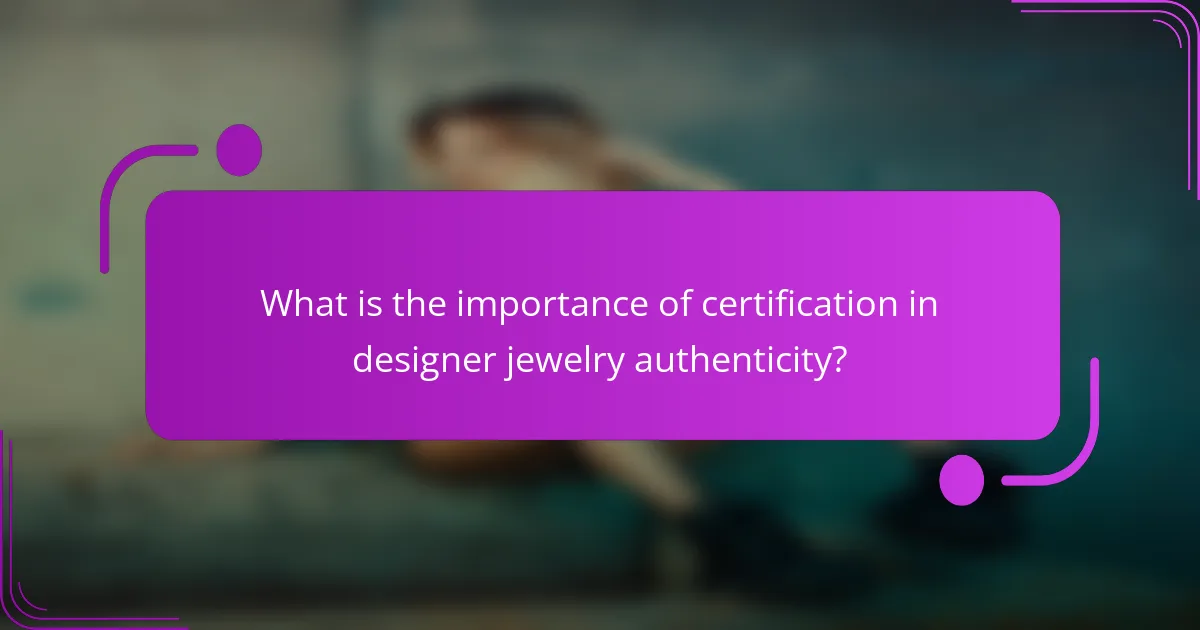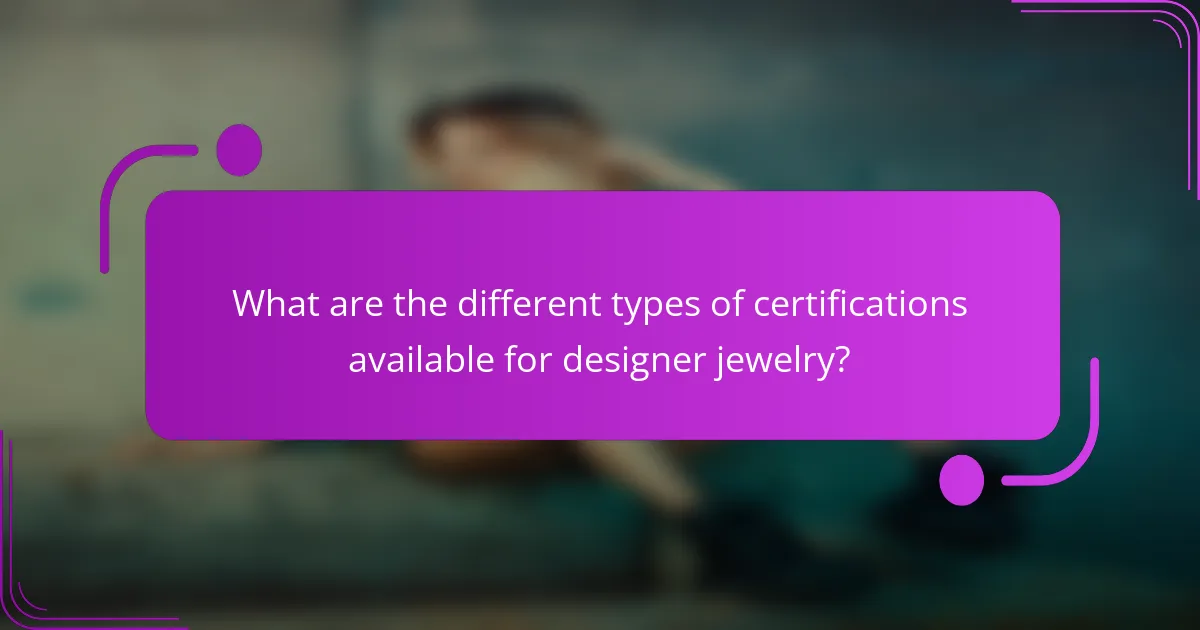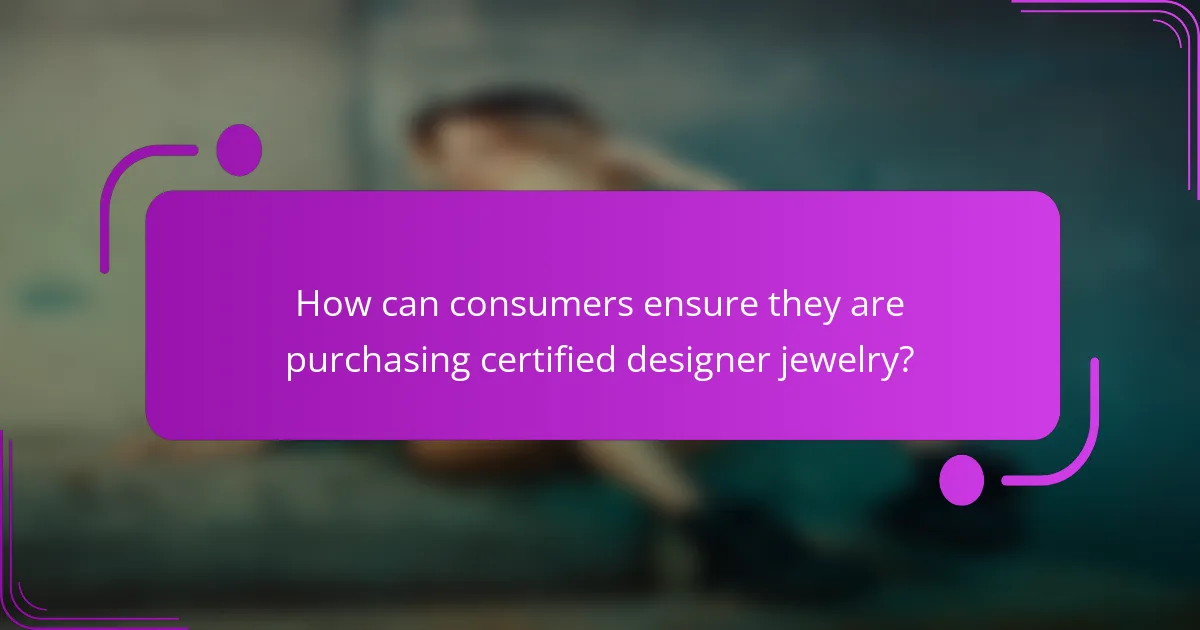Certification is essential for verifying the authenticity of designer jewelry, serving as proof that a piece is genuine and crafted by the claimed designer. This article explores the significance of certification in protecting consumers and enhancing the resale value of jewelry. It details various types of certifications, including those from the Gemological Institute of America (GIA), the International Gemological Institute (IGI), and the American Gem Society (AGS), which provide assurance of quality and authenticity. Additionally, the article offers guidance on how consumers can verify certifications and ensure they are purchasing from reputable sources, thereby minimizing the risk of counterfeit items.

What is the importance of certification in designer jewelry authenticity?
Certification is crucial for verifying designer jewelry authenticity. It provides proof that the piece is genuine and crafted by the claimed designer. Certified jewelry often comes with documentation detailing the materials and craftsmanship involved. This documentation helps consumers make informed purchasing decisions. Additionally, certification can enhance the resale value of the jewelry. According to the Gemological Institute of America, certified pieces are more trusted in the market. Buyers are more likely to invest in jewelry with verified authenticity. Thus, certification plays a vital role in protecting consumers and maintaining brand integrity.
How does certification contribute to the authenticity of designer jewelry?
Certification ensures the authenticity of designer jewelry by providing verified proof of its origin and quality. It involves a thorough evaluation by an accredited authority. This authority assesses the materials, craftsmanship, and design against industry standards. Certified jewelry typically comes with documentation that details its characteristics. Such documentation may include information about gemstones, metals, and brand authenticity. This process helps prevent counterfeits and assures buyers of the jewelry’s value. Additionally, certification can enhance resale value and buyer confidence in the market. Overall, certification plays a crucial role in maintaining trust and integrity in the designer jewelry industry.
What specific aspects of jewelry are verified through certification?
Jewelry certification verifies several specific aspects. These include the authenticity of materials used, such as precious metals and gemstones. Certification also assesses the quality and grade of these materials. Furthermore, it confirms the craftsmanship and design integrity of the piece. Certifications may validate the origin of gemstones, ensuring they are ethically sourced. Additionally, they provide information on the jewelry’s value and marketability. Each certified piece typically comes with a detailed report outlining these attributes. This process enhances consumer trust and protects against fraud in the jewelry market.
How does certification influence consumer trust in designer jewelry?
Certification significantly enhances consumer trust in designer jewelry. It serves as a guarantee of authenticity and quality. Certified jewelry often comes with documentation verifying its materials and craftsmanship. This documentation reassures consumers that they are purchasing genuine products. According to a survey by the Jewelers of America, 80% of consumers prefer certified jewelry. Certification also helps in preventing fraud and misrepresentation in the market. Consumers are more likely to invest in certified pieces, knowing they are protected. Overall, certification builds confidence in the purchase decision for designer jewelry.
Why is certification crucial for preventing counterfeiting in the jewelry industry?
Certification is crucial for preventing counterfeiting in the jewelry industry because it verifies the authenticity of materials and craftsmanship. Certified jewelry comes with documentation that proves its quality and origin. This documentation helps consumers make informed purchasing decisions. It also establishes trust between buyers and sellers. According to a report by the Jewelers of America, 70% of consumers prefer certified jewelry. Certification deters counterfeiters by creating a legal framework for accountability. This framework includes penalties for fraud, making counterfeiting less appealing. Overall, certification enhances the value and integrity of genuine jewelry.
What are the most common types of counterfeit designer jewelry?
The most common types of counterfeit designer jewelry include replicas, knock-offs, and fakes. Replicas are exact copies made to deceive consumers into believing they are authentic. Knock-offs are similar designs that mimic the style but are not exact copies. Fakes often use inferior materials to imitate genuine pieces without the brand’s logos. These counterfeits can be found in various forms such as rings, necklaces, and bracelets. The prevalence of counterfeit jewelry is significant, with estimates suggesting that approximately 20% of jewelry sold online may be counterfeit. This highlights the importance of certification in ensuring authenticity and protecting consumers.
How does certification help distinguish genuine pieces from fakes?
Certification helps distinguish genuine pieces from fakes by providing verified proof of authenticity. It involves a thorough examination by experts who assess the materials, craftsmanship, and design. Certified pieces often come with a unique identification number or certificate that confirms their origin. This documentation serves as a reliable reference point for buyers. For instance, the Gemological Institute of America (GIA) offers grading reports for diamonds that detail their quality. Such reports are widely recognized and trusted in the industry. Additionally, certification can increase the resale value of jewelry. Collectors and buyers prefer certified items due to their assurance of quality and authenticity.

What are the different types of certifications available for designer jewelry?
The different types of certifications available for designer jewelry include the Gemological Institute of America (GIA) certification, the International Gemological Institute (IGI) certification, and the American Gem Society (AGS) certification. GIA certification focuses on diamond grading and gemstone identification. IGI certification offers assessments for diamonds, colored stones, and jewelry. AGS certification emphasizes quality standards for diamonds and jewelry design. Each certification ensures authenticity and quality, providing buyers with confidence in their purchases.
How do various certification bodies differ in their approach?
Various certification bodies differ in their approach to designer jewelry authenticity through distinct criteria and processes. Some bodies emphasize gemological analysis, while others focus on craftsmanship and design originality. For example, the Gemological Institute of America (GIA) prioritizes detailed grading reports based on gem quality. In contrast, the International Gemological Institute (IGI) may also include assessments of design and brand heritage. Additionally, some certification bodies offer more stringent requirements for ethical sourcing and sustainability. These differences reflect the diverse values and standards within the industry, impacting the credibility and recognition of the certifications provided.
What criteria do certification organizations use to evaluate jewelry?
Certification organizations evaluate jewelry based on criteria such as quality, authenticity, and craftsmanship. They assess the materials used, including precious metals and gemstones. Organizations also examine the jewelry’s design and construction for durability and aesthetics. The presence of proper documentation, such as certificates of authenticity, is crucial. Additionally, organizations may consider industry standards and ethical sourcing practices. These criteria ensure that consumers receive high-quality and genuine products.
Which certifications are considered most reputable in the industry?
The most reputable certifications in the designer jewelry industry include the Gemological Institute of America (GIA) and the American Gem Society (AGS). The GIA is known for its rigorous grading standards and comprehensive gemology education. It offers certifications for diamonds and colored stones, which are widely recognized. The AGS focuses on diamond grading and is respected for its cut grading system. Both organizations maintain high standards for quality and integrity. Their certifications are often required by retailers and trusted by consumers. These certifications help ensure authenticity and quality in designer jewelry.
What role does certification play in the resale value of designer jewelry?
Certification significantly enhances the resale value of designer jewelry. It provides proof of authenticity and quality. Certified pieces are often more trusted by buyers. This trust leads to higher demand in the resale market. Studies show that certified jewelry can sell for 20-30% more than non-certified items. Certification also assures buyers of the jewelry’s origin and craftsmanship. This assurance reduces the perceived risk of purchasing high-value items. Overall, certification plays a crucial role in boosting confidence and value in designer jewelry transactions.
How does having a certification affect the resale market?
Having a certification positively affects the resale market for designer jewelry. Certification provides proof of authenticity and quality. This verification increases buyer confidence. Higher confidence often leads to higher resale values. Jewelry with certification can sell for 20-30% more than uncertified pieces. Certified jewelry tends to move faster in the market. Buyers are more willing to invest in certified items. This trend is supported by data from industry reports indicating the premium associated with certified pieces.
What impact does certification have on buyer confidence during resale?
Certification significantly boosts buyer confidence during resale. It serves as a verified assurance of authenticity and quality. Buyers are more likely to trust a certified piece, knowing it has been evaluated by experts. Research indicates that certified jewelry retains higher resale value. According to a study by the Gemological Institute of America (GIA), certified diamonds can sell for up to 20% more than non-certified ones. This increased confidence leads to quicker sales and less negotiation on price. Thus, certification plays a crucial role in enhancing buyer trust and investment security in the resale market.

How can consumers ensure they are purchasing certified designer jewelry?
Consumers can ensure they are purchasing certified designer jewelry by verifying the certification from reputable organizations. Look for certificates issued by recognized entities like the Gemological Institute of America (GIA) or the International Gemological Institute (IGI). These certifications provide detailed information about the jewelry’s quality and authenticity. Additionally, consumers should request documentation from the retailer that confirms the jewelry’s designer status. Researching the designer’s official website can also provide insights into authorized retailers. Checking for unique identifiers, such as serial numbers or holograms, can further confirm authenticity. Always purchase from reputable sources to minimize the risk of counterfeit items.
What steps should buyers take to verify jewelry certifications?
Buyers should take several steps to verify jewelry certifications. First, they should request the certification documents from the seller. These documents should include details about the gemological analysis and grading. Next, buyers should check the credentials of the certifying organization. Reputable organizations include the Gemological Institute of America (GIA) and the American Gem Society (AGS).
After that, buyers can verify the certification number listed on the documents. This can often be done through the certifying organization’s website. Additionally, buyers should inspect the jewelry for any inconsistencies with the certification details. This includes checking for the correct carat weight, clarity, color, and cut. Finally, buyers can seek a second opinion from a qualified gemologist if they have any doubts. These steps help ensure the authenticity and quality of the jewelry being purchased.
How can consumers identify legitimate certification marks?
Consumers can identify legitimate certification marks by checking for recognized certifying bodies. Legitimate marks often include logos or seals from reputable organizations. These organizations have established standards and protocols for certification. Consumers should verify the organization’s credibility through official websites. Cross-referencing the certification with the product’s documentation is also essential. Additionally, consumers can look for transparency in the certification process. Authentic certifications typically provide detailed information about the evaluation criteria. Research shows that 85% of consumers trust products with verified certifications, highlighting their importance in authenticity.
What resources are available for consumers to check jewelry authenticity?
Consumers can check jewelry authenticity through several resources. Reputable jewelers often provide certificates of authenticity. These certificates verify the quality and origin of the jewelry. Third-party appraisal services also offer authenticity verification. These services assess the jewelry based on industry standards. Online resources, such as the Gemological Institute of America (GIA), provide educational materials. They help consumers understand how to evaluate gemstones and metals. Additionally, consumer protection agencies provide guidelines on identifying counterfeit jewelry. These resources empower consumers to make informed purchasing decisions.
What best practices should consumers follow when seeking certified designer jewelry?
Consumers should verify the certification of designer jewelry before purchase. Look for reputable certification from recognized organizations. Ensure the certification includes details about the materials and craftsmanship. Research the designer’s background and reputation in the industry. Request documentation that proves authenticity and traceability. Compare prices with similar certified items to identify potential discrepancies. Consult customer reviews for insights on quality and service. Consider purchasing from established retailers with return policies. These practices help ensure the jewelry’s authenticity and value.
How can consumers educate themselves about jewelry certifications?
Consumers can educate themselves about jewelry certifications by researching reputable certification organizations. Organizations like the Gemological Institute of America (GIA) and the American Gem Society (AGS) provide detailed information on certification standards. They offer online resources, including articles and guides, that explain various certification processes. Consumers can also attend workshops or webinars hosted by these organizations. Reading books and articles written by gemologists can enhance understanding of the subject. Additionally, visiting jewelry stores that display certification information can provide practical insights. Engaging with online forums and communities focused on jewelry can facilitate knowledge exchange.
What questions should consumers ask sellers regarding certification?
What questions consumers should ask sellers regarding certification include: “What type of certification do you provide?” This question clarifies the credibility of the certification. Consumers should also ask, “Is the certification from a recognized authority?” This ensures the certification’s legitimacy and acceptance in the industry. Additionally, asking “Can you provide a copy of the certification?” allows consumers to verify the claims. Another important question is, “What specific criteria does the certification cover?” This helps consumers understand what aspects of authenticity are guaranteed. Lastly, consumers should inquire, “How often is the certification updated or renewed?” This indicates the seller’s commitment to maintaining standards.
The main entity of this article is designer jewelry certification, which is essential for verifying authenticity and quality. The article outlines the significance of certification in preventing counterfeiting, enhancing consumer trust, and increasing resale value. It details the specific aspects verified through certification, such as materials, craftsmanship, and ethical sourcing, while also discussing the most reputable certification organizations and their evaluation criteria. Additionally, it provides guidance for consumers on how to ensure they are purchasing certified designer jewelry and the best practices to follow for informed buying decisions.